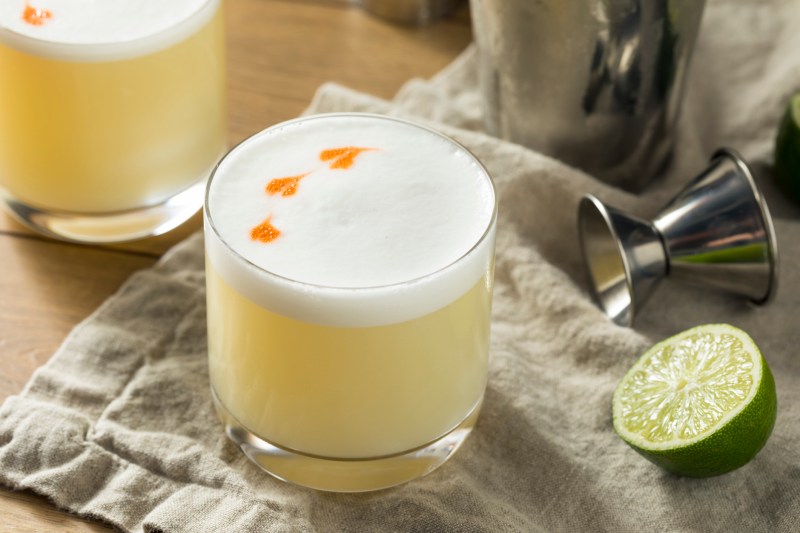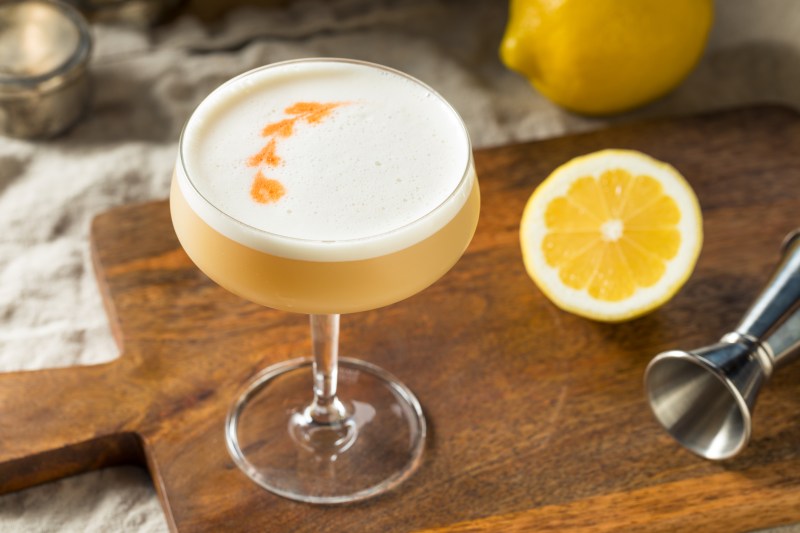
Claimed as a national drink by both Peru and Chile, the pisco sour has captivated cocktail lovers for over a century. Tart and sweet, with herbaceous and earthy notes and a rich, smooth finish, this South American gem suits any occasion. The success of this foamy, vibrantly hued beverage owes everything to pisco, its bold, complicated base spirit. Like brandy, pisco is a high-proof spirit made by distilling fermented grape juice, and it comes in a dizzying array of varieties.
Pisco sour recipe

Ingredients:
- 2 ounces pisco
- 1 egg white
- 3/4 ounce fresh Key lime juice
- 1/2 ounce simple syrup
- 3 dashes Angostura bitters
Method:
- Combine pisco, egg white, lemon juice and simple syrup in a cocktail shaker.
- Shake vigorously for 20 seconds.
- Add ice to the shaker, and shake again until well-chilled, about 15 seconds.
- Strain into an Old Fashioned glass.
- Top with bitters and serve.
Birth of a cocktail

Most cocktail historians credit the creation of the pisco sour to an American expat named Victor Vaughen Morris, working in Lima in the early 20th century. Magazine and newspaper advertisements for Morris’ invention date from around 1920, and the drink became all the rage among expats and upper-class Peruvians. Morris, who died in 1929, passed the torch to Mario Bruiget, a Peruvian bartender who worked at Morris’ Bar. Bruiget perfected the recipe and created the version favored today by adding bitters and an egg white to the cocktail. Chile disputes its provenance and claims the drink was invented in the 1900s in the northern town of Iquique.
Peru vs. Chile
The battle over pisco is just one more front in the ongoing rivalry between Peru and Chile — one that dates back hundreds of years. In the 17th century, the two countries were considered one territory, within the Spanish viceroyalty of Peru. Spanish colonists first planted grapevines in the south of present-day Peru back in the 1500s, and by the early 1600s, the first distilleries in Ica were already churning out pisco. Hacienda la Caravedo, the oldest continuously operating distillery in the Americas, opened in 1684.
Chile, on the other hand, claims that the indigenous community in the Elqui Valley was the first to make pisco. In the 1930s, future Chilean president Gabriel González Videla even renamed a town in the valley to Pisco Elqui in order to solidify its claims on the iconic spirit. Peru generally scoffed at such brazen attempts at legitimacy. After all, Peru has had a port town by the name of Pisco since the 17th century — one that grew wealthy from the international trade of the eponymous liquor produced nearby, and historical records demonstrated that the drink was consumed in Peru as early as 1613.
Regardless of its origin, no one can deny that both countries have a deep love for this versatile brandy. (Some might say Chileans hold the drink in higher esteem since they produce, consume, and export vastly more pisco than their northern neighbor.) Today, both countries have a national pisco sour day (Peru’s is the first Saturday in February, Chile’s falls on May 15), though, in truth, any of the other 363 days of the year are fine times to celebrate the perfection of this South American cocktail.
Pisco sour variations

Both Peruvian and Chilean pisco sours use lime juice, though some mixologists substitute lemon or even do a half-lemon-half-lime combination — the latter gets closest to the flavor profile of Peruvian lime, which is often described as a cross between a lemon and a lime. The Chilean version omits the egg white and bitters, for a more pisco-centric drink. Not surprisingly, the type of pisco used also plays a pivotal role in the cocktail. Production methods vary greatly between Peru and Chile; among other things, in Peru, eight different grapes can be used to produce pisco; in Chile, up to 13 different varietals can be used. In Peru, the aging happens in a neutral container like steel, while in Peru, Pisco can be aged in wood.
Once you’ve explored the variations between (and within) countries, you can branch out into other pisco cocktails. Pisco punch, which dates back to the Gold Rush days in San Francisco, is made with pineapple, giving the drink a more tropical flavor. A riff on the Moscow mule, the Peruvian mule contains ginger ale, pisco and a lime wedge. El Capitán gives a Latin makeover to the Manhattan with pisco, sweet vermouth, and
Ways to make it a variation
Here are some fun variations so you can try to explore different flavor profiles of the pisco drink.
- Berry infused: Add muddled berries like raspberries, blackberries, or strawberries for a burst of sweetness and color.
- Citrus twist: Swap the lime juice for grapefruit or blood orange juice for a tangy twist.
- Tropical touch: Add a splash of pineapple, passion fruit, or mango puree for a tropical vibe.
- Basil surprise: Add a few fresh basil leaves to the shaker for a subtle herbal flavor.
- Jalapeno heat: Muddle a sliver of jalapeno pepper (seeds removed for less heat) for a spicy and smoky flavor.



